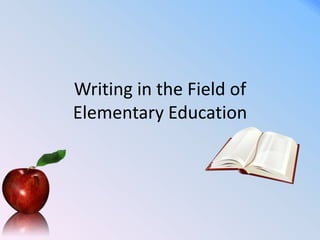
Writing in the field of education
- 1. Writing in the Field of Elementary Education
- 2. Overview The field of education uses a couple different writing styles: Psychological articles Step-by-step bullet points Sources are mainly primary sources like personal experiences with children or psychological experiments,but some do come fromsecondary (papers written by psychologists or other professionals that are referenced by the one doing the writing) The writing is generally subjective since the author puts their own thoughts into the article, like his studies on the learning process or the steps he found work best for teaching a certain topic.
- 3. …Continued Verbs are usually in the passive voice when giving the information since the students are the main focus, not the teacher. The majority of data is qualitative since there is little data in the form of numbers. Most data comes from observing what happens when the student is given a task. The genre is informative and the audience will usually be other teachers who want to find the best way to teach their students.
- 4. Psychological Articles These are useful when trying to understand a child’s learning process and style. Generally, the sentences are longer and the syntax is somewhat elevated from everyday speech. The article must present the material in a way that is easy enough for an average person to read but still sound educated.
- 5. Example “I certainly do not believe in just sitting in a classroom – which is unnatural, unhealthy, and should be limited. It is obvious we did not evolve to learn by sitting in classrooms, in segregated age groups…” (Geoff Haselhurst and Karene Howie, http://www.spaceandmotion.com/Philosophy-Education.htm ) Here, we see that the syntax and use of punctuation is easy to read, but it also sounds as if the author is serious as to what he is saying, which helps make the author appear to be a bit more reliable.
- 6. Step-by-Step Bullets These would come in handy when a teacher wants to easily see information to apply to their teaching. The points are short and sweet. They get the point across with as little explanation as possible. They may come in an outline-type arrangement with subheadings. These points could be informative or directional.
- 7. Example The Myers-Briggs Type Indicator (MBTI)This model classifies students according to their preferences on scales derived from psychologist Carl Jung's theory of psychological types. Students may be: extraverts (try things out, focus on the outer world of people) or introverts (think things through, focus on the inner world of ideas); sensors (practical, detail-oriented, focus on facts and procedures) or intuitors (imaginative, concept-oriented, focus on meanings and possibilities); thinkers (skeptical, tend to make decisions based on logic and rules) or feelers (appreciative, tend to make decisions based on personal and humanistic considerations); judgers (set and follow agendas, seek closure even with incomplete data) or perceivers (adapt to changing circumstances, resist closure to obtain more data). (http://www4.ncsu.edu/unity/lockers/users/f/felder/public/Papers/LS-Prism.htm) Here we see different types of ways people learn. The bullets are to the point and the information on each is as little as they can get away with without making it too vague.
- 8. Charts? Charts and graphs are used in education but mainly just for presenting information like the number of students that learn best one way versus another. A bar graph or line graph would be suitable for this. Most of the information has to be written out.
- 9. Texts and Citing Writing on teaching can be found anywhere. Psychological articles, internet pages, books, or even personal essays or articles on the subject. Citations in articles are usually referring back to psychologists who did studies on whatever educational topic the author is writing about. Since MLA style is the one often used in the school system, that is what is used in educational writings and are either right after the quote or can be found at the end of the paper.
- 10. Sources Used http://www4.ncsu.edu/unity/lockers/users/f/felder/public/Papers/LS-Prism.htm http://www.funderstanding.com/content/multiple-intelligences http://www.spaceandmotion.com/Philosophy-Education.htm http://www.regentsprep.org/Regents/math/ALGEBRA/AD1/qualquant.htm http://ide.ed.psu.edu/idde/9events.htm